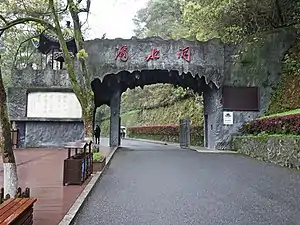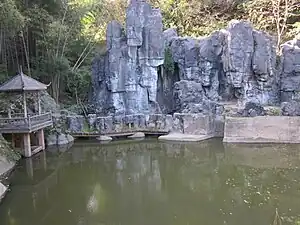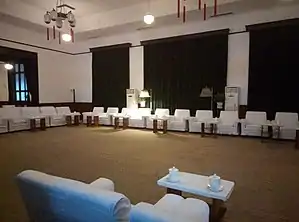
Dishui Cave (Chinese: 滴水洞; pinyin: Dīshuǐdòng; lit. 'Dripping Water Cave'), also known as Dishui Hole or Mount Dishui, is a mountain with many caves. It is regarded as a "pearl" of the landscape of Shaoshan. The mountain is the farthest end of the long valley of Shaoshan. The rocks of the valley have been worn into caves by the dripping water of a stream. The caves are close to Dishuidong Mountain, Longtoushan Mountain (龙头山) on the south, the Huxieping Mountain (虎歇坪) on the north and the Niuxingshan Mountain (牛形山) at the back. There are great varieties of rare trees and flowers, such as azalea, camellia, cymbidium, camphor, cherries, ginkgo and others which are in blossom in different seasons.[1][2][3][4]
Climate
Dishui Cave is in the subtropical monsoon climate zone and exhibits four distinct seasons. Its climate characterized by torrid summers, chill winters and high humidity.
Gallery
 The entrance. |
 |
 A pond. |
 |
 Conference Room. |
 Mao's room. |
See also
References
- ↑ He Qiuyun (贺秋云); Jiang Guoping (蒋国平); Qi Peigen (齐培根); Zhang Xinghuang (张星煌) (1991). "Foreword" 《序言》. 《中国韶山》 [China Shaoshan]. Fuzhou, Fujian: Huayi Publishing House. p. 2. ISBN 9787800392726.
- ↑ 韶山滴水洞的福根竟有如此大的影响力?. huaxia.com (in Chinese). 2017-09-21.
- ↑ 滴水洞景区新增福根堂景点. 163.com (in Chinese). 2017-04-29.
- ↑ 毛主席晚年回韶山异常神秘 养老“滴水洞”到底有多少秘密. iFeng (in Chinese). 2016-09-06.